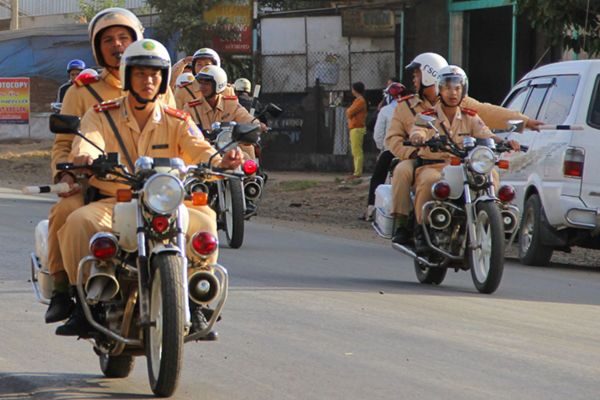Can the Mobile Police Handle Violations When Participating in Patrols and Controlling Road Traffic Order and Safety?
Do Mobile Police have the authority to handle violations when participating in patrolling, controlling road traffic order and safety?
Pursuant to Chapter IV of Circular 32/2023/TT-BCA, Traffic Police can mobilize other police forces to coordinate in patrolling and controlling road traffic order and safety when necessary.
According to the provisions of Article 32 of Circular 32/2023/TT-BCA, it is regulated as follows:
Mobilized forces and conditions for mobilized officers and soldiers
1. Mobilized forces: Other police forces under the People's Public Security.
2. Conditions for mobilized officers and soldiers
Mobilized officers and soldiers participating in patrolling, controlling road traffic order and safety in cooperation with Traffic Police must thoroughly understand and master the provisions of road traffic law, regulations on administrative violation handling, decrees on administrative penalties in the field of road traffic, and regulations on road traffic patrolling and control.
According to Article 3 of the Law on Mobile Police 2022, the provisions are as follows:
Position and function of the Mobile Police
The Mobile Police is a people's armed force under the Vietnam People's Public Security, serving as the core force to implement armed measures to protect national security and ensure social order and safety.
Based on the above provisions, it can be understood that the Mobile Police is a people's armed force under the Vietnam People's Public Security, serving as the core force to implement armed measures to protect national security and ensure social order and safety.
Thus, the Mobile Police can be mobilized to coordinate in patrolling, controlling road traffic order and safety when necessary, and handle traffic violations according to their authority while performing these duties.

Do Mobile Police have the authority to handle violations when participating in patrolling, controlling road traffic order and safety? (Image from the Internet)
Under what circumstances can Traffic Police stop vehicles to conduct control?
According to the provisions of Clause 1, Article 16 of Circular 32/2023/TT-BCA, there are 4 cases where traffic police officers performing patrol duties can stop vehicles to conduct control as follows:
(1) Direct detection or through professional technical means and equipment, detection and collection of road traffic law violations and other legal violations;
(2) Execution of commands or plans for comprehensive control of vehicles to ensure road traffic order and safety, social order; patrol, control, specialized violation handling plans to ensure road traffic order and safety, social order, which have been issued by competent authorities;
(3) Written requests from the Head or Deputy Head of the investigation agency; written requests from relevant functional agencies regarding stopping vehicles to conduct control to serve the work of ensuring security and order; crime prevention and control; disaster prevention and rescue; disease prevention and control; rescue and dealing with other legal violations. The written request must specify the time, route, vehicle to be stopped for control, handling, and coordinating forces;
(4) Information and reports, reflections, petitions, and denunciations from organizations and individuals about law violations by people and vehicles participating in road traffic.
What is the process for Traffic Police to conduct control?
According to the provisions of Article 18 of Circular 32/2023/TT-BCA, the process for Traffic Police to conduct control is carried out as follows:
Step 1: Request the vehicle driver to implement safety measures and get off the vehicle.
Step 2: Perform a salute according to the People's Public Security Order (except for cases where it is known in advance that the person has committed a crime, caught in the act, or is wanted). When interacting with individuals who violate the law, the Traffic Police officer must maintain proper demeanor, composure, and appropriate conduct.
Step 3: Inform the vehicle driver and passengers about the reason for the control; request the vehicle driver to present relevant documents or information from the electronic identification account of relevant documents.
Step 4: Conduct control as specified in Clause 2, Article 12 of Circular 32/2023/TT-BCA
- Control relevant documents related to individuals and vehicles.
- Control the conditions for vehicle participation in traffic.
- Control compliance with road transport safety regulations.
- Control other related contents as stipulated by law.
For passenger vehicles with 10 or more seats, or passenger vehicles comparable in size to those with 10 or more seats, it is necessary to directly board the passenger compartment to conduct control and notify the result.
Step 5: Conclude the control
The Traffic Police officer reports the control results to the Team Leader, notifies the vehicle driver and passengers about the control results, violations (if any), and the handling measures.
*Note:
- When there is a basis to believe that there are concealed evidence, means, or documents used in administrative violations in the person, transport means, or goods, searches can be conducted according to the law on administrative violation handling.
- In case signs of crime are detected, proceed according to the provisions of the criminal procedure law.
LawNet